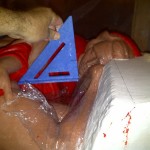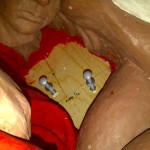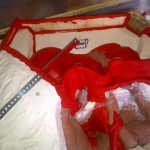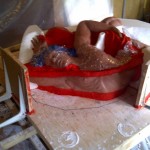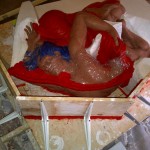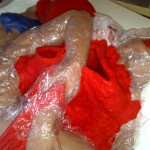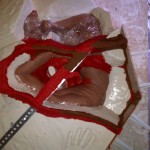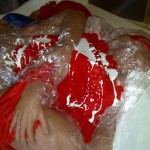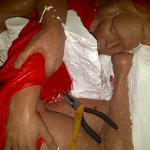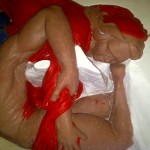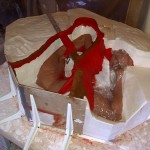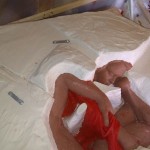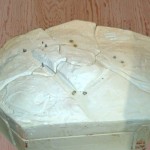Some time ago, in my post “preparing your plaster mold”, I outlined the step by step process of planning the construction of a plaster mold. Each section must pull away smoothly without any undercuts. With my new Pieta Amare, this will prove very challenging as both Mother and Son are facing each other with their hands clasped together and sandwiched between them. For this project, I will need to work separately on the body, face and hands. Then reassemble the pair after the clay has been cast.
Tag Archives: Plaster Mold Making
Pour or Press Clay into Plaster Mold
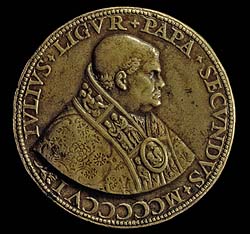 As I have previously mentioned, Michelangelo would normally not have pressed or poured clay into prepared plaster molds. Though he did have experience working with bronze and the making of casts, he preferred to simply jump from the maquette stage directly to carving marble. With the master’s near bottomless supply of financial support… literally buckets of ducats, he could afford to live well on the florins shovelled out by Florence. Papal Scudos, Parman Neapolitan Piastras. (sounds yummy)
As I have previously mentioned, Michelangelo would normally not have pressed or poured clay into prepared plaster molds. Though he did have experience working with bronze and the making of casts, he preferred to simply jump from the maquette stage directly to carving marble. With the master’s near bottomless supply of financial support… literally buckets of ducats, he could afford to live well on the florins shovelled out by Florence. Papal Scudos, Parman Neapolitan Piastras. (sounds yummy)
But in today’s world, the working artist needs to be self supportive. And having an inventory of “clay originals” for sale will help you during the long years ahead wile you lovingly labour on stone. Continue reading
Pouring Plaster
Plaster is one of the oldest man made building materials, after fired Clay. Dating back almost 10,000 years, it was first used in Jordan and then expanded throughout all ancient cultures; from Egypt to China.
Michelangelo was very familiar with this medium, used to create his brilliant fresco the Last Judgment, and the ceiling in the Sistine Chapel.
As an artist, I can’t help but feel awe inspired as I continue to use this material following in the footsteps of a thousand generations.
Before getting started pouring the mold for the maquette, make sure you gather all supplies in advance and have them ready at hand. (see Tools of the Trade)
You will naturally pour one section at a time. Each piece will have a defined border that you will mark with an indelible pen or scribe with a knife.
Look down a straight edge to see if there are any “undercut areas” this can now be filled in with plasticine. Remember that if your plaster form wraps behind your Maquette, then later, as you separate the mold, the clay behind this undercut will be gouged or clawed away. Do your best, but remember that clay is forgiving and you can repair mistakes later on in the process. As this will be a very heavy piece, I have planned for bolts to be cast within the plaster. This way, later I will be able to attach a winch to help lift the weight.
Your wood forms, having been pre-cut, will be fastened to the workspace deck using shelf brackets and “Robertson” screws.
Warm your plasticine in a used electric skillet and then run this paste into the edges between forms and the deck of your work area.
To avoid a mess, spills and sticking, protect the adjacent area with plastic wrap. Soft plasticine will be used to follow the contours of your statue and provide a watertight seal against the wood form. (just make sure that the plasticine and your Maquette are separated by the plastic wrap or they will stick together)
Coat all exposed previous sections of plaster with brushed on Vaseline. This will ensure that pieces will separate once finished. (without Vaseline, this 12 piece mold would end up as one solid block of plaster.) Plaster will not stick to modeling clay, or plasticine, but bonds permanently to itself.
As you become familiar with the weight of liquid plaster, you will adjust the thickness and strength of your forms… When I started I had several “Blow Outs” and there is nothing worse than a gallon of plaster slipping out over your statue and onto the floor. So always construct your form as strong as possible.
Now you’re ready to mix and pour. (remember.. you must use a mask and eye protection)
If you click on this link, you should be able to download a PDF with all the mixing details. But, don’t bother, art is all about hands and eyeballs.
From my experience, the best mixture is 73 parts water, to 100 parts ‘No 1’ Plaster…
So, to make life easy, mark two equal sized buckets – Fill the first with 5 measured litres of water (mark the shadow line “5 Plaster”) – and then Fill the second bucket with 3.65 litres of water (mark the shadow line “3.65 Water”)
A third larger 10 litre bucket will be used to mix. Sift the plaster into the water letting the water naturally absorb the powder. When done correctly, you should see an island slowly submerge into the milky water. Once all the plaster has been added and is under water, wait a minute, and then mix with your hand feeling for any lumps. Within approximately 5 minutes of gently stirring, the water will resemble milky coffee cream and will be ready to pour.
Remember to only mix as much as you can pour in 5 minutes or less. So it is important to have an idea of how much plaster is needed.
Calculating your volume is easy… length x height x width… great, if your sculpture is a cube, but not for the Pieta… so I normally have two or three pre-measured unmixed loads ready to quickly combine and add.
The plaster will cure in a hour or less, depending on water and air temperature. However, it will become impossible to work with quickly, in a matter of minutes… If you need more time, then use cold water. But 20 degrees celcius will yield the best results.
As plaster cures, it will heat, once the temperature has cooled, it will be ready to have the forms removed and cleaned. This is the best time to smooth out the surface, easily done with wooden carving tools. Once the irregular surface has been worked, then let the section dry overnight before repeating the process on the next piece.
Once done, (several weeks later), you will have a large multi-piece plaster block. This will need to dry in a well ventilated room for at least two more weeks or until dry to the touch. If the block feels cooler than the ambient air, it is still wet. If you prematurely try to open the mold while it is still damp, it may crack or crumble.
My Pieta required over a month to dry
Preparing your Plaster Mold
Michelangelo would normally not have created plaster castings of his maquettes. He would either fire the clay as is, or simply allow the sun to dry the template.
Under protest, he was commissioned to create a bronze sculpture of Pope Julius ll, and complained in writing to his family how the process was exceptionally challenging. The Maquette he used was full size and weighed almost as much as the final bronze. Continue reading




